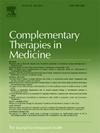Tai Chi as a mind-body exercise modulates endothelial function in coronary artery disease: A randomized clinical trial
IF 3.5
3区 医学
Q1 INTEGRATIVE & COMPLEMENTARY MEDICINE
引用次数: 0
Abstract
Objectives
Tai Chi (TC), a mind-body aerobic exercise, has emerged as a potential alternative therapeutic modality for patients with coronary artery disease (CAD). Endothelial function is an important prognostic indicator in CAD. However, the effects of TC on endothelial function in CAD patients compared to aerobic exercise (AE) remain understudied.
Design
A parallel-group, assessor-blinded, randomized clinical trial (RCT).
Setting
Wanjie Rehabilitation Hospital and Anzhen Community Health Service Centre.
Participants
The present study enrolled 48 patients diagnosed with coronary artery disease (CAD), of whom 37 completed the 12-week intervention, 17 in the Tai Chi (TC) group and 20 in the aerobic exercise (AE) group.
Interventions
Both groups received supervised training three times a week at 40–60 % heart rate reserve (HRR), an intensity corresponding to the ventilatory anaerobic threshold (VO₂AT). Each 60–75-minute session consisted of four phases: 10–15 min of warm-up, 20–30 min of moderate-intensity Tai Chi’s Bafa Wubu (Eight Methods and Five Steps) or structured aerobic exercise (AE), 10–15 min of moderate-intensity Tai Chi elastic band exercises or resistance training, and 10–15 min of cool-down.
Main outcome measures
The primary outcome was endothelial function, assessed by biomarkers including nitric oxide (NO), endothelin (ET), vascular cell adhesion molecule-1 (VCAM-1), and intercellular adhesion molecule-1 (ICAM-1). Secondary outcomes included lipid profiles measured by high-density lipoprotein (HDL), total cholesterol (TC), triglycerides (TG), and low-density lipoprotein (LDL).
Results
Baseline characteristics were not significantly different between groups (P > 0.05). After 12 weeks, both TC and AE groups showed significant improvements in endothelial function: NO levels increased, while ET, VCAM-1, and ICAM-1 decreased (P < 0.05). HDL levels increased only in the AE group (P < 0.05). TC, TG, and LDL remained unchanged in both groups (P > 0.05).
Conclusions
Tai Chi, as a mind-body exercise, may improve endothelial function in patients with CAD, even when serum lipid levels remain unchanged, providing benefits comparable to those of aerobic exercise (AE) despite different effects on high-density lipoprotein (HDL).
This trial has been registered on ClinicalTrials.gov (registration number: NCT03936504).
太极拳作为一种身心运动调节冠状动脉疾病的内皮功能:一项随机临床试验。
目的:太极拳(TC)是一种身心有氧运动,已成为冠状动脉疾病(CAD)患者的潜在替代治疗方式。内皮功能是CAD的重要预后指标。然而,与有氧运动(AE)相比,TC对CAD患者内皮功能的影响仍未得到充分研究。设计:平行组、评估盲、随机临床试验(RCT)。单位:万杰康复医院、安贞社区卫生服务中心。参与者:本研究招募了48名诊断为冠状动脉疾病(CAD)的患者,其中37人完成了为期12周的干预,17人在太极(TC)组,20人在有氧运动(AE)组。干预措施:两组均接受监督训练,每周三次,40-60%心率储备(HRR),强度与通气无氧阈值(vo2at)相对应。每次60-75分钟的训练由四个阶段组成:10-15分钟的热身,20-30分钟的中等强度太极拳八法五步(八法五步)或结构化有氧运动(AE), 10-15分钟的中等强度太极拳弹力带练习或阻力训练,10-15分钟的冷却。主要结局指标:主要结局指标是内皮功能,通过生物标志物评估,包括一氧化氮(NO)、内皮素(ET)、血管细胞粘附分子-1 (VCAM-1)和细胞间粘附分子-1 (ICAM-1)。次要结局包括通过高密度脂蛋白(HDL)、总胆固醇(TC)、甘油三酯(TG)和低密度脂蛋白(LDL)测量的脂质谱。结果:两组患者基线特征差异无统计学意义(P < 0.05)。12周后,TC组和AE组内皮功能均有明显改善:NO水平升高,ET、VCAM-1、ICAM-1水平降低(P < 0.05)。仅AE组HDL升高(P < 0.05)。两组患者TC、TG、LDL无显著差异(P < 0.05)。结论:太极作为一种身心运动,可以改善冠心病患者的内皮功能,即使在血脂水平不变的情况下,其益处与有氧运动(AE)相当,尽管对高密度脂蛋白(HDL)的影响不同。该试验已在ClinicalTrials.gov上注册(注册号:NCT03936504)。
本文章由计算机程序翻译,如有差异,请以英文原文为准。
求助全文
约1分钟内获得全文
求助全文
来源期刊

Complementary therapies in medicine
医学-全科医学与补充医学
CiteScore
8.60
自引率
2.80%
发文量
101
审稿时长
112 days
期刊介绍:
Complementary Therapies in Medicine is an international, peer-reviewed journal that has considerable appeal to anyone who seeks objective and critical information on complementary therapies or who wishes to deepen their understanding of these approaches. It will be of particular interest to healthcare practitioners including family practitioners, complementary therapists, nurses, and physiotherapists; to academics including social scientists and CAM researchers; to healthcare managers; and to patients. Complementary Therapies in Medicine aims to publish valid, relevant and rigorous research and serious discussion articles with the main purpose of improving healthcare.
 求助内容:
求助内容: 应助结果提醒方式:
应助结果提醒方式:


